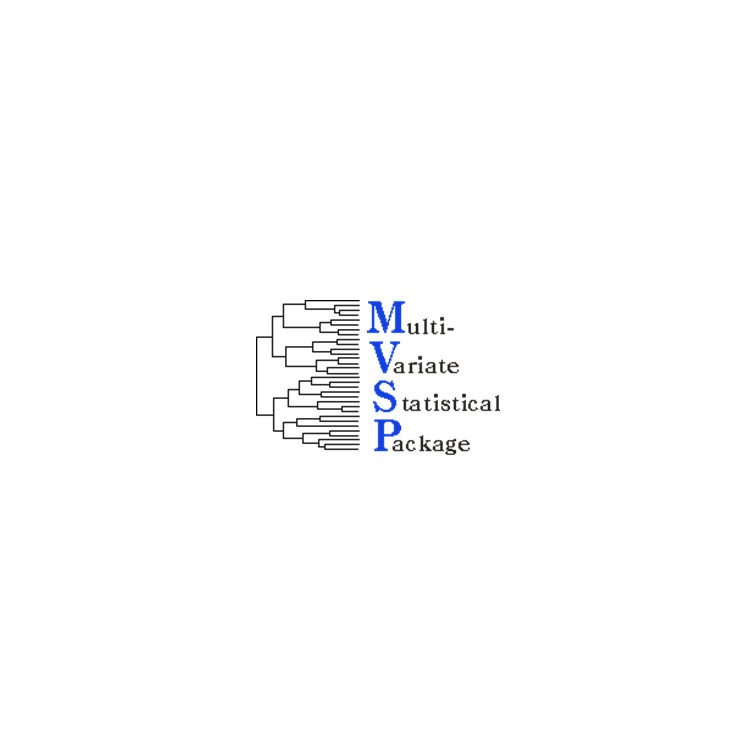MVSP v3 多變數統計分析軟體

- MVSP v3 多變數統計分析軟體
-
類別統計分析軟體
-
介紹MVSP is an inexpensive and easy to use program that performs a number of multivariate numerical analyses useful in many scientific fields. It calculates three basic types of eigenanalysis ordinations: principal components, principal coordinates, and correspondence/detrended correspondence analyses.
MVSP v3 Multivariate Statistical Analysis Software
• Easy to use, with modern Windows interface (configurable
toolbar, context menus, simple menu structure).
• Numerous user-defined options that are automatically
saved for future use.
• Saveable desktop; you can save all the results, graphs
and notes of the current analysis session to disk, then
restore them later to resume where you left off.
• Unlimited number of variables and cases (restricted
only by available Windows memory, including both
RAM and hard disk swap file).
• Data matrix manipulation:
• Built in spreadsheet-like data editor; includes full
multilevel undo capabilities, row and column
deletion and insertion.
• Transposition of matrix.
• Transformation of data, using logarithms to base
10, e, and 2, square root, Aitchison’s logratio for
percentage data, and standardization. Individual
variables may be selected for transformation.
• Conversion to range through format for stratigraphic
studies.
• Can assign individual cases to pre-designated groups;
these are then shown on results and graphs.
• Merging of several data files into one.
• Data import and export; Lotus 1-2-3 and Symphony,
Excel, Quattro, xBase, Paradox, SIMSTAT, plain text
and Cornell Ecology Programs.
• Import process eased by the use of the Import
Preview dialog; lets you preview the imported
data and change options to ensure successful
results.
• Analyses:
• Easy selection of variables and cases to include
in analysis; no need to modify original data.
• Principal Components Analysis, with the following
options: correlation or covariance matrix, centred
or uncentred analysis, user defined number of axes
to extract, including Kaiser’s and Jolliffe’s rules for
average eigenvalues, user defined accuracy level.
• Principal Coordinates Analysis, performed with the
following options: use any type of input similarity
matrix, user defined number of axes to extract and
accuracy level.
• Correspondence Analysis, with these options: Hill’s
detrending by segments, choice of cyclic Jacobi or
reciprocal averaging algorithm, weighting of rare
or common taxa and scaling to percentages, user
defined number of axes to extract and accuracy
level, choice of alternative scalings for representing
cases vs. variables.
• Canonical Correspondence Analysis, a technique highly
popular in ecological studies for incorporating environmenta
l variables into an ordination of species distributions.
• Twenty three different similarity and distance measures,
including Euclidean, squared Euclidean, standardized
Euclidean, cosine theta (or normalized Euclidean),
Manhattan metric, Canberra metric, Bray Curtis, chord,
squared chord, chi-square, average, and mean character
difference distances; Pearson product moment correlation
and Spearman rank order correlation coefficients; percent
similarity, modified Morisita’s similarity and Gower’s general
similarity coefficient; Sørensen’s, Jaccard’s, simple matching,
Yule’s, Nei’s and Baroni-Urbani Buser's binary coefficients.
• Cluster analysis, with the following options: seven strategies
(UPGMA, WPGMA, median, centroid, nearest and farthest
neighbour, and minimum variance (or Ward's)), constrained
clustering in which the input order is maintained (e.g. stratigr
aphic studies), randomized input order, integral dendrogram
production. Dual clustering of both variables and cases with
a sorted data matrix being produced; allows patterns to be
seen in the data.
• Diversity indices, with the following options: Simpson’s,
Shannon’s, or Brillouin’s indices, choice of log base,
evenness and number of species also calculated.
• Graphics
• Scatterplots (2-d and 3-d) of variables in raw data.
• Box and whisker plots of raw data.
• Scatterplots (2-d and 3-d) of PCA, PCO and CA/CCA
results.
• Joint plots (scatterplot of variables and cases together)
for CA/CCA results.
• Euclidean biplots (scatterplot of cases with variables
plotted as vectors) of PCA results.
• CCA biplots, with environmental variables as vectors or,
for nominal variables, as centroids.
• Scree plots of eigenvalues from PCA, PCO and CA/CCA
results.
• Points on scatterplot can be identified by clicking on
point. Also can have labels applied to all points.
• When cases are assigned to groups scatterplots show
different symbols for each group. Symbol and color used
is user definable.
• Dendrograms of clustering results (both graphic and text-
based).
• Zoom in on graphs to view specific areas more closely.
• Fully customizable; can modify fonts, titles, colours,
background style, axis scaling and placement, type and
colour of scatterplot symbol. All settings saved for future
use.
• Save graphs as BMP or WMF files, or copy to Windows
clipboard for transfer to other programs.

系統需求
Microsoft Windows 98/Windows NT 4 or later (including Windows ME/2000/XP/2003/Vista/7/8/10)
RAM:
8 Mb RAM memory
HD:
5 Mb disk space

MVSP v3 多變數統計分析軟體
• 易於使用,具有現代 Windows 界面(可配置的工具欄、上下文菜單、 簡單的菜單結構)。
• 許多用戶定義的選項會自動保存以備將來使用。
• 可保存的桌面;您可以將當前分析會話的所有結果、圖形和註釋保存
到磁盤,然後在稍後恢復它們以從上次中斷的地方繼續。
• 無限數量的變量和案例(僅受可用的 Windows 內存限制,包括
RAM 和硬盤交換文件)。
• 數據矩陣操作:
• 內置類似電子表格的數據編輯器;包括完整的多級撤消功能、
行和列刪除和插入。
• 矩陣的轉置。
• 數據轉換,使用以 10、e 和 2 為底的對數、平方根、百分比
數據的 Aitchison 對數比和標準化。可以選擇單個變量進行轉換。
• 通過地層研究的格式轉換為範圍。
• 可以將個別案例分配給預先指定的組;然後將它們顯示在結果和圖
表上。
• 將多個數據文件合併為一個。
• 數據導入導出;Lotus 1-2-3 和 Symphony、Excel、Quattro、
xBase、Paradox、SIMSTAT、純文本和康奈爾生態學程序。
• 使用導入預覽對話框簡化了導入過程;讓您預覽導入的數據並更改選
項以確保獲得成功的結果。
• 分析:
• 輕鬆選擇要包含在分析中的變量和案例;無需修改原始數據。
• 主成分分析,具有以下選項:相關或協方差矩陣、中心或非中心
分析、用戶定義的要提取的軸數,包括平均特徵值的 Kaiser 和
Jolliffe 規則、用戶定義的準確度級別。
• 主坐標分析,使用以下選項執行:使用任何類型的輸入相似性矩陣、
用戶定義的要提取的軸數和精度級別。
• 對應分析,具有以下選項:Hill 的分段去趨勢、循環 Jacobi 或倒數
平均算法的選擇、稀有或常見分類群的加權和百分比縮放、用戶定義
的要提取的軸數和準確度級別、用於表示案例的替代縮放的選擇與
變量。
• 規範對應分析,一種在生態研究中非常流行的技術,用於將環境變量
納入物種分佈的排序。
• 二十三種不同的相似性和距離度量,包括歐幾里得、平方歐幾里得、
標準化歐幾里得、餘弦 theta(或歸一化歐幾里得)、曼哈頓度量、
堪培拉度量、布雷柯蒂斯、和弦、平方和弦、卡方、平均和平均字符
差異距離; Pearson 積矩相關和 Spearman 秩次相關係數;百分比相
似度,修正的 Morisita 相似度和 Gower 的一般相似係數;Sørense
n's、Jaccard's、簡單匹配、Yule's、Nei's 和 Baroni-Urbani Bus
er 的二元係數。
• 聚類分析,具有以下選項:七種策略(UPGMA、WPGMA、中值、
質心、最近和最遠鄰居以及最小方差(或 Ward's))、保持輸入順
序的約束聚類(例如地層研究)、隨機輸入順序,積分樹狀圖產生。
變量和案例的雙重聚類,生成一個排序的數據矩陣;允許在數據中
看到模式。
• 多樣性指數,有以下選項:辛普森指數、香農指數或布里淵指數,
對數基數的選擇、均勻度和物種數量也計算在內。
• 圖形
• 原始數據中變量的散點圖(2-d 和 3-d)。
• 原始數據的箱線圖。
• PCA、PCO 和 CA/CCA 結果的散點圖(2-d 和 3-d)。
• CA/CCA 結果的聯合圖(變量和案例的散點圖)。
• PCA 結果的歐幾里得雙標圖(將變量繪製為向量的案例散點圖)。
• CCA 雙標圖,以環境變量作為向量,或者對於名義變量,作為質心。
• 來自 PCA、PCO 和 CA/CCA 結果的特徵值的碎石圖。
• 散點圖上的點可以通過點擊點來識別。也可以將標籤應用於所有點。
• 當案例被分配到組時,散點圖為每個組顯示不同的符號。使用的符號
和顏色可由用戶定義。
• 聚類結果的樹狀圖(基於圖形和文本)。
• 放大圖形以更仔細地查看特定區域。
• 完全可定制;可以修改字體、標題、顏色、背景樣式、軸縮放和位
置、散點圖符號的類型和顏色。保存所有設置以備將來使用。
• 將圖形保存為 BMP 或 WMF 文件,或複製到 Windows 剪貼板以傳
輸到其他程序。

PROSuite 統計分析軟體
ProSuite 是 Provalis Research 的集成文本分析工具(QDA Miner、WordStat、SimStat)的集合,允許人們探索、分析和關聯結構化和非結構化數據。Provalis Research 文本分析工具允許使用 QDA Miner 對文檔和圖像執行高級計算機輔助定性編碼,將 WordStat 強大的內容分析和文本挖掘功能應用於文本數據,以及對數值和分類數據執行高級統計分析使用 SimStat。ProSuite 不會將研究人員和分析師限制在單一的文本分析方法中,而是允許他們選擇最適合研究問題或可用數據的方法。
PASS 2022 統計分析軟體
PASS 軟體為超過 1100 個統計測試和置信區間場景提供樣本大小工具 -是任何其他樣本大小軟體的兩倍多。每個工具都經過了已發表的文章和/或文字的仔細驗證。 PASS 配備整合文件與PhD統計人員支援。 PASS 經過 20 多年的微調,現已成為臨床試驗、製藥和其他醫學研究的領先樣本量軟體選擇。它還已成為所有其他需要樣本量計算或評估的領域的支柱。
UNISTAT 10.11 統計分析套裝軟體
UNISTAT是視窗型統計分析軟體,運行於Windows平臺之上,其統計分析功能齊全、多種運行模式、介面友好、可操作性強、資料輸人輸出靈活。

